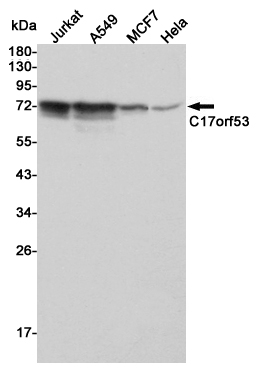-
Product Name
Anti-C17orf53 (7E1) Mouse antibody
- Documents
-
Description
C17orf53 (7E1) Mouse monoclonal antibody
-
Tested applications
WB
-
Species reactivity
Human
-
Isotype
Mouse IgG2a
-
Preparation
Antigen: Purified recombinant fragment of human C17ORF53 (AA: 282-527) expressed in E. Coli.
-
Clonality
Monoclonal
-
Formulation
Purified antibody in PBS with 0.05% sodium azide
-
Storage instructions
Store at 4°C short term. Store at -20°C long term. Avoid freeze / thaw cycle.
-
Applications
WB: 1/500 - 1/2000
ELISA: 1/10000
-
Validations

Western blot detection of C17orf53 in Jurkat,A549,MCF7 and Hela cell lysates using C17orf53 mouse mAb (1:1000 diluted).Predicted band size:70KDa.Observed band size:70KDa.
-
Background
Swiss-Prot Acc.Q8N3J3.C17orf53 (chromosome 17 open reading frame 53) is a 647 amino acid protein that is encoded by a gene mapping to human chromosome 17. Chromosome 17 makes up over 2.5% of the human genome with about 81 million bases encoding over 1,200 genes. Two key tumor suppressor genes are associated with chromosome 17, namely, p53 and BRCA1. Tumor suppressor p53 is necessary for maintenance of cellular genetic integrity by moderating cell fate through DNA repair versus cell death. Malfunction or loss of p53 expression is associated with malignant cell growth and Li-Fraumeni syndrome. Like p53, BRCA1 is directly involved in DNA repair, specifically it is recognized as a genetic determinant of early onset breast cancer and predisposition to cancers of the ovary, colon, prostate gland and fallopian tubes. Chromosome 17 is also linked to neurofibromatosis, a condition characterized by neural and epidermal lesions, and dysregulated Schwann cell growth. Alexander disease, Birt-Hogg-Dube syndrome and Canavan disease are also associated with chromosome 17.
Related Products / Services
Please note: All products are "FOR RESEARCH USE ONLY AND ARE NOT INTENDED FOR DIAGNOSTIC OR THERAPEUTIC USE"
